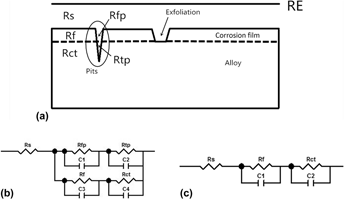Crossref Citations
This article has been cited by the following publications. This list is generated based on data provided by
Crossref.
Peng, Zhuowei
Pan, Qinglin
Cai, Shan
Li, Jinfeng
and
Liang, Wenjie
2019.
Effect of different aging processes on the corrosion behavior of new Al–Cu–Li–Zr–Sc alloys.
Materials and Corrosion,
Vol. 70,
Issue. 12,
p.
2266.
de Sousa Araujo, João Victor
Santos Bugarin, Aline de Fátima
Donatus, Uyime
Machado, Caruline de Souza Carvalho
Queiroz, Fernanda Martins
Terada, Maysa
Astarita, Antonello
and
Costa, Isolda
2019.
Thermomechanical treatment and corrosion resistance correlation in the AA2198 Al–Cu–Li alloy.
Corrosion Engineering, Science and Technology,
Vol. 54,
Issue. 7,
p.
575.
Georgoulis, Dimitris
Charalampidou, Christina M.
Siskou, Nikoleta
Alexopoulos, Nikolaos D.
and
Kourkoulis, Stavros K.
2020.
Corrosion behaviour of AA2198–T8 and AA2024-T3 alloy in 3.5% aqueous solution.
Procedia Structural Integrity,
Vol. 28,
Issue. ,
p.
2297.
Liu, Dan-Yang
Li, Jin-Feng
Lin, Yong-Cheng
Ma, Peng-Cheng
Chen, Yong-Lai
Zhang, Xu-Hu
and
Zhang, Rui-Feng
2020.
Cu/Li Ratio on the Microstructure Evolution and Corrosion Behaviors of Al–xCu–yLi–Mg Alloys.
Acta Metallurgica Sinica (English Letters),
Vol. 33,
Issue. 9,
p.
1201.
Araujo, João Victor de Sousa
Silva, Rejane Maria Pereira da
Donatus, Uyime
Machado, Caruline de Souza Carvalho
and
Costa, Isolda
2020.
Microstructural, Electrochemical and Localized Corrosion Characterization of the AA2198-T851 Alloy.
Materials Research,
Vol. 23,
Issue. 4,
de Souza Carvalho Machado, Caruline
Donatus, Uyime
Milagre, Mariana Xavier
Araujo, João Victor de S.
de Viveiros, Barbara Victoria G.
Klumpp, Rafael Emil
Pereira, Victor Ferrinho
and
Costa, Isolda
2021.
How microstructure affects localized corrosion resistance of stir zone of the AA2198-T8 alloy after friction stir welding.
Materials Characterization,
Vol. 174,
Issue. ,
p.
111025.
de Souza Carvalho Machado, Caruline
da Silva, Rejane Maria Pereira
de Sousa Araujo, João Victor
Xavier Milagre, Mariana
Donatus, Uyime
de Viveiros, Bárbara Victoria Gonçalves
Emil Klumpp, Rafael
and
Costa, Isolda
2021.
Influence of chloride ions concentration on the development of severe localised corrosion and its effects on the electrochemical response of the 2198-T8 alloy.
Corrosion Engineering, Science and Technology,
Vol. 56,
Issue. 4,
p.
341.
Shi, Chunchang
Wu, Guohua
Zhang, Liang
Zhang, Xiaolong
Sun, Jiangwei
Zhang, Jinshuo
and
Wang, Yixiao
2021.
Variation in the microstructure and mechanical properties of permanent mold cast Al–3Li–2Mg–0.1Zr alloy with Zn addition.
Journal of Materials Research,
Vol. 36,
Issue. 10,
p.
2071.
Wang, Jian
Yang, Ke
Bai, Zhi-hao
Lu, Ya-lin
Zhu, Xiu-rong
Wang, Jun
and
Pang, Song
2022.
Microstructural evolution and mechanical behaviors of Al-Cu-Li alloy processed by laser shock peening.
Materials Characterization,
Vol. 191,
Issue. ,
p.
112125.
Georgoulis, Dimitris
Charalampidou, Christina M.
and
Alexopoulos, Nikolaos D.
2022.
Corrosion resistance of aluminum alloy 2198 for different ageing tempers.
Procedia Structural Integrity,
Vol. 37,
Issue. ,
p.
941.
Wu, C.H.
Li, H.
Bian, T.J.
Lei, C.
and
Zhang, L.W.
2022.
Natural aging behaviors of Al-Cu-Li alloy: PLC effect, properties and microstructure evolution.
Materials Characterization,
Vol. 184,
Issue. ,
p.
111694.
Charalampidou, Christina Margaraita
Tazlakidou, Foteini
Kourkoulis, Stavros K.
and
Alexopoulos, Nikolaos D.
2022.
The effect of solution aggressiveness on corrosion-induced mechanical properties degradation of aeronautical aluminum alloy 2198.
Procedia Structural Integrity,
Vol. 42,
Issue. ,
p.
1708.
Gad, Shedrack Musa
Jin, Zelong
Emad, Seydgholamreza
Vergara, Javier Espinoza
Yawas, Danjuma Saleh
Dagwa, Ishaya Musa
and
Momoh-Bello Omiogbemi, Ibrahim
2023.
Potential of rare-earth compounds as anticorrosion pigment for protection of aerospace AA2198-T851 alloy.
Heliyon,
Vol. 9,
Issue. 3,
p.
e14693.
Liu, Cansen
Wu, Xianhong
Xu, Jianyu
Li, Jinyan
and
Xie, Huisi
2023.
Electrodeposited Co-WS2 composite coatings with resistance to fouling, wear, and corrosion.
Journal of Solid State Electrochemistry,
Vol. 27,
Issue. 12,
p.
3487.
Wang, Zhige
Dong, Liang
Hu, Bin
and
Chen, Bin
2023.
The Effect of Cu Addition on Corrosion Resistance of Al-Si-Mg-Cr Alloy.
Metals,
Vol. 13,
Issue. 4,
p.
795.
Sangali, Marcio
Opini, Victor C.
Fatichi, Alberto Z.
Mello, Mariana G.
Fanton, Leonardo
Caram, Rubens
and
Cremasco, Alessandra
2023.
Nb modified Ti-5553 alloy: Effects of heating rate on mechanical properties, corrosion behavior, and crystallographic texture.
Journal of Materials Research and Technology,
Vol. 23,
Issue. ,
p.
5310.
Araujo, João Victor de S.
Silva, Rejane Maria Pereira da
Viveiros, Bárbara Victoria Gonçalves de
Klumpp, Rafael Emil
and
Costa, Isolda
2024.
Estudo do comportamento eletroquímico de uma liga Al-Cu-Li.
Matéria (Rio de Janeiro),
Vol. 29,
Issue. 1,
Maritsa, Stavroula
Deligiannis, Stavros
Tsakiridis, Petros E.
and
Zervaki, Anna D.
2024.
Experimental and Computational Study of Microhardness Evolution in the HAZ for Al–Cu–Li Alloys.
Crystals,
Vol. 14,
Issue. 3,
p.
246.
Jagadeesh, C
H, Shivananda Nayaka
S, Prithivirajan
S, Ramesh
and
Anne, Gajanan
2024.
On the microstructure, texture and electrochemical properties of severely deformed and artificially aged lightweight AA2050 Al–Cu–Li alloy.
Materials Research Express,
Vol. 11,
Issue. 3,
p.
036509.
Nandakumar, K.
Lenin, K.
and
Ajith Kumar, K. K.
2024.
Corrosion Behaviour of Cryogenic-Treated Dissimilar FSW Al Alloys.
Transactions of the Indian Institute of Metals,
Vol. 77,
Issue. 1,
p.
145.





